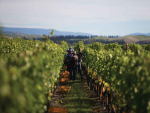Sauvignon Blanc Celebration 2016: David Gleave
Once again we talk to a couple of the guest speakers who will be attending the International Sauvignon Blanc Celebration 2016.
Have you ever wondered why you can smell a particular aroma in a glass of wine, but no one else can?
Or why it is that the word you use to describe a certain smell is different to the word others would use? The simple answer to both questions is perception.
That was one of the great lessons to come out of an enlightening session at the recent Sauvignon Blanc Celebration. Olfactory genius and a man referred to world-wide as "the nose", Alexandre Schmitt explained how perception impacts on our ability to describe aromas.
The former French perfumer turned to the world of wine 15 years ago, when he was approached by Jean-Claude Berrouet winemaker at Château Petrus. Berrouet wanted to learn to be able to smell aromas better while Schmitt wanted to learn more about wine. The pair began a 12-year relationship that saw each learn from the others' skillset. These days Schmitt spends his time travelling the world, teaching winemakers, writers and sommeliers the language of olfactory.
And there is a lot of language to learn, given Schmitt himself can distinguish 1500 different aromas. Fifteen-hundred? I for one was unaware that there were that many aromas in the world. Although he was quick to point out to me, that he was nowhere near the top of the game when it comes to current perfumers in France. They can smell anywhere up to 5000, which he describes as being at the top of the human limit.
When it comes to wine though, Schmitt says the aromas fall into five distinct categories; woody, resin, balsamic, floral and citrus. Break those categories down into individual aromas and hundreds of descriptors appear, depending on the perception of the person smelling.
"Perception is a personal experience," he said. "It resorts to memories, representations, image associations that differ from one person to another. We all have the same sense of smell, but we don't have the same perception." Much of that perception is based on experiences and is influenced by our major sense – sight. Schmitt explained that in terms of the senses, sight makes up 65 percent, hearing around 25, touch 15 or slightly more, while both smell and taste only account for roughly one percent each. He is helping winemakers throughout the world utilize those other senses, with the aim of creating a common olfactory language.
"The idea is to help humans acquire olfactory knowledge, since our knowledge is basically visual. The brain structure is based on the visual, so when we think, we use the sense of sight, we need to visualize. Olfaction or knowledge of aromas requires abstraction, which is a mental and intellectual act."
As an example he referred to the word cedar.
"Whenever I mention the word cedar, most people visualize a tree. It may be a large tree, branches or a conifer. But olfactory knowledge indicates the aromas of cedar, which is altogether resinous. It can be very fresh possibly evoking turpentine, pine sap, wax or polish. On the other hand it has an extremely drying aspect as well which can be the aroma of old paper, or old newspapers or pencil shavings. They are very different and this is something that the person needs to register."
It is not just sight that impacts on either the taste or smell of a wine.
"Olfactory sense cannot be isolated from other senses. When we taste a wine, other senses are brought into play. So there are elements in the recognition of wines, like for example, the sense of touch when minerality is referred to. Or when you describe a wine as being silky or velvety, you refer to the sense of touch. If you describe a wine as round or linear, you are referring to the sense of sight. Olfactory does not have a vocabulary of its own, which is why we constantly use words that come from taste, touch or hearing."
Think of the word spiciness as a descriptor – that comes from a sense of taste rather than smell, yet it often appears as an aroma descriptor.
While there were no bottles of wine to prove his point, Schmitt had a number of glass vials, each containing a different aromatic component. Sticks dipped into the individual vials were then handed out to the audience, who were encouraged to describe what they were smelling.
There was a wide range of words coming from throughout the room, and while some may have laughed at loud at some of them – Schmitt was at pains to point out that there is no right or wrong answer – it's all about perception.
So while perception is all important and accounts for the variability between individual's descriptors, Schmitt says it should not be confused with sensation. This is something that is quantifiable. There is a right and a wrong. You cannot confuse acidic with tannic, or concentration.
I guess what everyone wanted to know at the end of the seminar, was if they could improve their olfactory skills. You can says Schmitt, but it takes time, concentration and effort. (Think of Berrouet, it took him 12 years to master it).
While Schmitt can identify 1500 aroma compounds, an oenologist could possibly identify around 80, the average layperson can only pick up close to 20 in a blind smelling. To increase that knowledge, he says you would need to be training with hundreds of different aromas every day. In fact a perfumer is expected to smell up to 800 a day, every day.
Which probably means that people like myself will never gain the heady heights of "The Nose", but at least I am happy to know my perception of what I am smelling is neither right nor wrong.

OPINION: Sauvignon Blanc was famously introduced to New Zealand by Ross Spence of Matua Valley, and then serendipitously planted in…

OPINION: As New Zealand's wine industry grapples with figurative dark clouds (and literal for some wine regions of late) this…
Fifteen premium Marlborough wineries have found a home away from home in the region, with a shared cellar door in…
The large 2025 harvest will exacerbate the wine industry's "lingering" supply from recent vintages, New Zealand Winegrowers Chief Executive Philip…
Marlborough grape growers Will and Jayne Grigg are "cautiously optimistic" about the future of the region's wine industry.